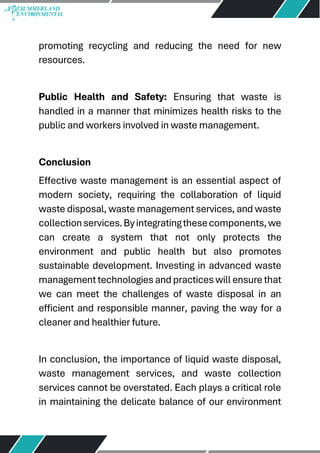Some Known Details About Reclaim Waste
Some Known Details About Reclaim Waste
Blog Article
Indicators on Reclaim Waste You Need To Know
Table of ContentsLittle Known Facts About Reclaim Waste.Rumored Buzz on Reclaim WasteSome Known Details About Reclaim Waste Getting My Reclaim Waste To WorkThe Ultimate Guide To Reclaim Waste
Check out the kinds, incidents, and forms of fluid waste. Residential sewage waste refers to the waste and products from a domestic septic system. This kind of waste is developed by people in houses, colleges, and various other buildings. This only consists of septic containers that have a drainpipe field. The proper management and disposal of domestic sewer waste require liquid waste to be moved to a sewage treatment plant where the proper techniques and devices are applied to detoxify and take care of waste.
Industrial waste commonly consists of possible hazards, such as flammable materials or a combination of liquid and strong waste products, and needs an advanced and thorough disposal procedure. The disposal of business waste usually includes the filtering of waste prior to transportation to make sure risk-free and correct disposal. Industrial waste is produced from by-products and drainage of commercial processes and production.
This type of waste can not utilize the very same sewer monitoring transportation or processes as septic or industrial liquids. The hazardous waste monitoring procedure requires the examination and testing of liquid waste before it undergoes the disposal process (liquid waste disposal). Drainage waste is the fluid waste that originates from overflow and excess stormwater in extremely inhabited locations or cities
Drainage waste can create contamination and flooding otherwise dealt with appropriately. Find out more about drain cleansing and waste monitoring. Making sure correct waste management can stop disasters and decrease ecological damage. Both people in residential setups and specialists in business or production industries can benefit from understanding the processes and regulations of fluid waste administration.
The Definitive Guide to Reclaim Waste
Get in touch with PROS Services today to find out about our waste administration and disposal solutions and the proper methods to care for the liquid waste you produce.
(https://www.anyflip.com/homepage/imqzz#About)Do you understand what happens to your water when you disengage, flush the bathroom or drain the washing equipment? No? Well, it deserves knowing. This supposed 'wastewater' is not only a vital resource but, after therapy, will certainly be launched to our land, waterways or the ocean. Made use of water from commodes, showers, baths, kitchen sinks, washings and industrial processes is called wastewater.

water used to cool equipment or tidy plant and tools). Stormwater, a kind of wastewater, is drainage that moves from agricultural and city areas such as roofings, parks, gardens, roadways, courses and seamless gutters right into stormwater drains, after rain. Stormwater moves unattended straight to neighborhood creeks or rivers, ultimately getting to the sea.
Reclaim Waste Fundamentals Explained
In Queensland, the majority of wastewater is treated at sewage therapy plants. Wastewater is delivered from residential or commercial websites through a system of drains and pump terminals, known as sewage reticulation, great post to read to a sewer treatment plant. City governments construct, maintain and run most sewage treatment plants. Operators are accredited under the Environmental Defense Act 1994 to release cured wastewater at an acceptable ecological requirement right into waterways.
The Division of Natural Resources encourages city governments concerning handling, operating and maintaining sewerage systems and treatment plants. In unsewered locations, neighborhood federal governments may require householders to mount specific or house sewer treatment systems to treat residential wastewater from commodes, cooking areas, bathrooms and washings. The Department of Natural Resources authorises making use of family systems when they are shown to be effective.
In some new subdivisions, therapy of some stormwater to remove clutter, sand and gravel has actually begun making use of gross contaminant catches. Wastewater treatment occurs in 4 phases: Eliminates solid issue.
Wastewater after that streams into big tanks where solids work out and are removed as sludge. Oil and scum are skimmed from the surface. Makes use of tiny living microorganisms referred to as micro-organisms to damage down and get rid of remaining dissolved wastes and fine particles. Micro-organisms and wastes are incorporated in the sludge. Gets rid of nitrogen and phosphorus nutrients that might create algal flowers in our rivers and threaten aquatic life.
More About Reclaim Waste
Nutrient elimination is not available at all sewage treatment plants because it calls for expensive specialised devices. Clear liquid effluent produced after treatment may still contain disease-causing micro-organisms - industrial wastewater treatment.

Many wastewater flows right into the sewerage system. Under the Act, local federal governments provide authorizations and licences for environmentally pertinent activities (Periods) including wastewater releases that may have a local influence.
Reclaim Waste for Dummies
Monitoring supplies accurate details about water high quality and can verify that licence conditions are being satisfied. The info acquired with surveillance gives the basis for making water top quality decisions.
Report this page